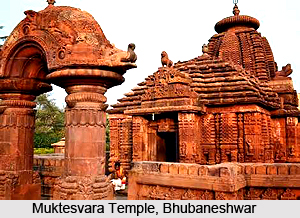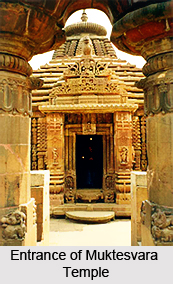 Muktesvara Temple, also popularly known as `Muktesvara Deula` is an ancient Hindu temple which is dedicated to Lord Shiva, located in Bhubaneshwar, Odisha. It is believed to have been erected during the 10th century. Muktesvara Temple represents a significant development of Hindu temples in the area of Odisha. The architectural styles of adapted while creating this temple marks the combination of the previous architectural patterns of the other temples, which continued further and was introduced in Lingaraja Temple and Rajarani Temple, both based in Bhubaneshwar. The term `Muktesvara` implies `Lord of Freedom` and is used to signify the Hindu God, Lord Shiva.
Muktesvara Temple, also popularly known as `Muktesvara Deula` is an ancient Hindu temple which is dedicated to Lord Shiva, located in Bhubaneshwar, Odisha. It is believed to have been erected during the 10th century. Muktesvara Temple represents a significant development of Hindu temples in the area of Odisha. The architectural styles of adapted while creating this temple marks the combination of the previous architectural patterns of the other temples, which continued further and was introduced in Lingaraja Temple and Rajarani Temple, both based in Bhubaneshwar. The term `Muktesvara` implies `Lord of Freedom` and is used to signify the Hindu God, Lord Shiva.
History of Muktesvara Temple
Muktesvara Temple is one the oldest works belonging to the Somvamsi period. According to some scholars, the Muktesvara Temple was built after the construction of Parasurameswar Temple, but prior to the creation of Brahmeswara Temple during the 1060 CE. The unique characteristics of this ancient temple is the `torana`, which was absent in all the contemporary temples of that time. It is believed that Yayati I, who was the Somavamsi ruler had contributed to the erection of this temple.
Architecture of Muktesvara Temple
Muktesvara Temple is considered as an architectural marvel, which is precisely the reason why this temple is also referred to as the `Gem of Odisha architecture`. It faces towards the west and comprises a lower a basement. However, one of the most striking characteristic of this temple was the presence of the `jagamohana` or the pyramidal terrace, which was a major breakthrough in temple architecture, since this temple was the very first one to demonstrate this exclusive feature. The `Torana` or arched gateway which dates back to 900 CE portrays the influence of Buddhist style of architecture. Thick pillars embellished with bead strings and jewels carved on statues of women are quite impressive. Horizontal and vertical lines inside the chambers of the porch impart an idea of moderate height to Muktesvara Temple. Beautiful female figurines as well as idols of peacocks and monkeys adorn the entrance of the temple.

The `Vimana` of the temple is built on a raised platform and is square in shape. Four `Nataraja` figures are created inside the `shikara` and four `kirthimukhas` are also present. `Kalasa` is referred to the upper portion of the shikara which measures about 10.5 metres in height and is decorated with sculpted figures and architectural motifs. This temple also contains `bho` which is a brand new form of decoration which was utilized in this temple and later adopted by several other temples of Odisha. This is an elaborately adorned `chaitya` window which crowned by a gigantic masked demon head and also some dwarf figures. Sculptures depicting `Nagas` and `Naginis` ornament the sanctum sanctorum of the Muktesvara Temple.
Jagamohana measures about 35 metres and it is embellished with magnificent carvings carried out by the Vishwakarma Moharana sculptors. This temple is also said to be a `gem of Nagara architecture`, during the era of Kalinga architecture. Outstanding statues of saints and voluptuous ladies, embedded with ornaments have been employed to beautify the carvings of the temple, which have been created with the aide of red sandstone. Idols of Yamuna and Ganga are carved close to Prachanda and Chanda. On the lintel of jagamohana is existent an idol of Lakulisa, holding a `lakuta`. Figurines of Ketu, Rahu and Gajalakshmi are also sculpted in the interiors of Muktesvara Temple. One will come across the image of a lion which is present near the side roof of the jagamohana.
Three hooded snakes attached to Ketu can be noticed in the doorway which leads to the sanctum of the temple. Ketu is said to be the ninth planet as per Hindu mythology. A well is present on the south-western corner and a tank stands on the eastern part of the temple. Devotees believe that taking a dip in the sacred waters of this well cures infertile ladies. Some other shrines based in the premises of this temple are utilized for offering prayers. Beautiful sculptures have been used to decorate the exteriors and the interiors of Muktesvara Temple.
Figurines of Hindu deities like Lord Ganesha, Lakulisha and Goddess Saraswati are existent on the outer side of the compound. A popular belief which asserts that if infertile women take a holy dip in Madicha Kunda tank inside the temple, especially on the night prior to Ashokastami Car Festival, she would be blessed by Lord Shiva and consequently give birth to sons. A three-day dance festival known as `Mukteswar Dance Festival` is organised every year in the premises of this famous temple, by the Department of Tourism of the State Government. During this dance festival, the classical dance of Odissi is performed by renowned dancers.











